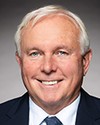Mr. Speaker, much as I am disappointed to see this motion come forward in the manner it has, I am also happy to see that we are having this conversation and debate today, because over 35,000 people have died from a toxic drug supply in this country since 2016.
This is not an opioid crisis as the motion states; rather, these deaths have occurred because of a toxic, unregulated drug supply, and I am going to speak to a couple of things in the motion.
First, (iii) of the motion states:
since tax-funded drug supply was ramped up in 2020, opioid deaths have only gone up, according to the Public Health Agency
Yes, of course, they have. Between 2016 and 2020, fentanyl became the predominant drug on the market, meaning more people were accessing it instead of pills like oxycontin. Fentanyl analogs, like carfentanil and benzodiazepines, also appeared in the drug supply at this time. More people have died because the fentanyl supply has become more widely accessible and more volatile.
There were fewer than 1,000 people across Canada, probably around 500, accessing safe supply in 2020, with a denominator of tens of thousands of people were using fentanyl, and probably hundreds of thousands. There were 22,000 people who died from an overdose by 2020 under the current government. It is impossible that the 500 people or fewer who were on safe supply, the mass majority of whom are alive in 2023, drove those 22,000 deaths. Conservatives need to learn to do the math and listen to the experts.
It states in (iv) of the motion:
in 2020, slightly less than 7,000 people died of opioid overdoses, while only 3,000 died of overdoses in 2016, according to the Library of Parliament
Again, Conservatives cannot back that up. Those people died from a toxic drug supply. We know these deaths are not occurring because of the government's safe supply and safe injection programs, and to assert that is disinformation.
I am going to talk about some of the activists the government has highlighted. It said that activists are leading the safe supply charge. We know that provincial chief coroners and chief medical health officers across the country, like in my home province, and the police have said that.
I will read a quote from the Canadian Association of Police Chiefs, which made it very clear that its members cannot police their way out of this because it is a health issue. It proposed “diverting people dealing with substance abuse or addiction issues away from the criminal system and toward social services and health care. The association stipulated such a change would need to be synchronized nationally.” The government has not done this.
It also cited in its report that it “endorsed access to users of a safe supply pharmaceutical-grade opioids to combat the uncertain composition of illegal street drugs, which is the cause of many opioid overdoses.”
“It further made a recommendation in favour of supervised consumption sites — where people could use drugs in a clean, safe environment, under the supervision of health professionals trained in emergency intervention.”
The activists are supporting safe supply. This is deeply concerning when I see the Conservative leader cite that it is only activists who are advocating.
Also, there is one thing in the speech by the Conservative leader that I would like to correct. He talked about incidents of youth being trafficked safer supply.
Today, in The Globe and Mail:
Vancouver Police, asked...about the possible sale of such narcotics, said in a recent statement that “there's always a potential” for safe-supply medication to be sold on the illicit market.
However, the force added they are not aware of any incidents in Vancouver in which safe supply has been trafficked to youth...
This was in response to the comments the Conservative leader has made here in the House of Commons. I can assure the House that the members of the Vancouver police know and are certain that youth are being targeted with illegal, unregulated, poisoned drugs, such as fentanyl, which is not regulated. This is what we are dealing with.
In (vi) of the motion it states:
recently, a Global News reporter in East Vancouver was able to buy 26 hits for $30 in just 30 minutes of a dangerous and highly addictive opioid that is distributed in tax-funded drug supply programs and flooding our streets with cheap opioids,
People can buy anything on that corner and have been able to for decades, at least over 50 years, so it is not great evidence if they go to the most robust drug-selling corner in Canada and that is what they come back with.
The photos of what they purchased show that most drugs were in a blister pack. A blister pack is issued to one patient. So, the Global reporter bought most of the 26 pills from just one person, and it is not evidence of a wide-scale diversion to buy from one person.
The motion today could have been about calling on the government to create an emergency committee of Parliament to deal with the toxic drug crisis. It is the leading cause of unnatural death in my home province; more than motor vehicle accidents, more than homicide and more than death by suicide. However, the Conservatives did not do that. They chose to bring forward this motion, which creates more stigma and more harm actually.
A person who decides to use a single dose of a toxic drug at a weekend party is as vulnerable as any struggling person with problematic substance use, and the result can be the same: a fatal, toxic drug overdose. I know this, because in my home community, we have seen lots of people die, and lots of young men. The average age of people who are dying is 44, and the majority of them are men dying at home alone.
Guy Felicella, a peer clinical supervisor at the B.C. Centre on Substance Use, said that “People who aren't ready, able or interested in addressing their addiction don't deserve to die from the toxic drug supply.” I agree.
I have risen in the House on many occasions, as members know very well, in support of a health-based approach to substance use. I would like to welcome all members from all sides of the House who are joining our call for increased investment to respond to this crisis and for people who are suffering with substance use disorder. The sooner we can actually come together across political lines to make this happen, the sooner we are going to save lives.
This is a national health crisis, and we are not acting like that. However, we need to understand what we are dealing with when looking at this crisis. It is not the easy, simplistic approach that the Conservatives are bringing forward. This crisis will never end through just investing in treatment and recovery without recognizing that this is a complex emergency, it is multi-faceted and it requires harm reduction as well, which go hand in hand; they are not pitted against each other.
Government members want to say that they are doing everything they can, but they spent less than 1% of what they spent on the COVID-19 health crisis. This is not responding to a health crisis in the way that needs to happen. We saw how they responded to SARS, HIV and COVID, and they need to do what they did there. They need to pull everyone together. They cannot just download treatment and recovery to the provinces. We saw what Portugal did. It stepped up and showed us what courage looks like and what is needed: investments in therapeutic treatment, housing and ensuring that we are dealing with this issue as a health crisis, not a criminal issue. It takes a multi-faceted approach, and I am really encouraging that today, but we need to simply do more of what we talked about.
We need to listen to experts. It is so important that everybody in the House listen to the experts. I travelled across this country when I was talking about my bill, Bill C-216, which was just a reflection of the Expert Task Force on Substance Use. I was able to meet with people on the front line of this crisis, such as people who use substance and experts, and the whole time they encouraged us to listen to the report.
The Canadian Association of Chiefs of Police of Canada, as I have cited, has come forward very much in alignment with the expert task force, and actually had a seat on that task force. The task force was unanimous in that we need to stop criminalizing people who use substances, we need to expunge records of people who have been charged with personal possession, and we need to ensure that people have access to a safe supply and treatment on demand. So, we meet them where they are at and we invest in recovery, education and prevention, because we know that when people relapse, we need to catch them, but we also need to meet them where they are at through the whole thing.
My bill was defeated, as members know. The Conservatives teamed up with the majority of the Liberals and they voted against my bill, which was supported by the Bloc, the Greens and the NDP. I know that members of the Bloc had some issues with my bill, but they wanted to at least get it to committee and listen to the experts, which both the Conservatives and Liberals would not do, despite the fact that it just reflected the government's own Expert Task Force on Substance Use.
Moms Stop the Harm is coming to the Hill on the anniversary of the bill, which comes up not next week, our break week, but when we come back. It will be June 1. They are coming here because they are upset that, a year later, not a lot has changed. That bill would have given the government 12 months to come back with a strategy on how to respond to the expert task force on substance use, but they voted against it. I am hoping that every member in this House will at least meet the moms, and when they go back to their riding, talk to their chief medical health officer. I have not found one chief medical health officer, or a coroner, who does not support taking a multi-faceted approach and supporting safer supply.
I also urge the leader of the official opposition to meet with the chiefs of police. Hopefully, again, he will meet with the moms from Moms Stop the Harm. I know that the leader of the official opposition has been using Global News reports, the National Post and even Conrad Black to get his advice on how to move forward in terms of this toxic drug crisis.
We really need to get back to ensuring that we are listening to the report by the expert task force. I want to talk about who was on it. There were public health officials; indigenous health leaders; community health leaders; business, labour, university and social service agencies; the Canadian Association of Police Chiefs; public policy thinkers; and people with lived and living experience. They were unanimous in their recommendations. I want to give huge credit and thanks to that task force, because they put a lot of work in. Again, they embraced the four-pillar approach.
I understand that it takes courage to make this journey. We saw courage in Vancouver under former senator Larry Campbell. He was a police officer, then the chief coroner for British Columbia and then the mayor of Vancouver. He was the one who brought in Insite and safe consumption sites to save lives. That is the kind of courage we need today from everybody here. Again, we can look to other countries, such as Portugal, for their treatment and recovery programs. We can look at Switzerland, which has a safe supply model. There are models around the world.
I hope that we can come together today and talk about how we can find a pathway to actually work together. However, the stigma that is attached to substances is a huge barrier for people when it comes to getting help. We know that even today's motion is triggering a lot of people who use substances and were looking at safe supply as a pathway out of supporting the unregulated toxic drug supply that is coming from the streets. This supply is manufactured, distributed and marketed through organized crime.
We know we need to go further. We have to invest in a full spectrum to support people who use substances, including supervised consumption sites; real-time, on-demand public treatment options; and pharmaceutical-grade options and alternatives to illegal street drugs. We also have to ensure that people have housing. I was in the riding of my good colleague, the member for Cowichan—Malahat—Langford, and we went to a no-barrier housing place. It was great to see some of the people there being able to access OAT or safer supply, which they could not do when they were homeless, living in the bush or living wherever they could. We need to make sure that this is included.
When we call for more treatment services, let us recognize that, first, we must keep people alive by reducing their exposure to the toxicity of illegal street drugs. My good friend, the member for Vancouver East, represents the Downtown Eastside, a community struggling for survival and ravaged by toxic drug deaths. She once told this House that dead people cannot be treated. How true is that?
I just want to also do some fact checking here. I am going to read a quote from Corey Ranger. He is a clinical nurse specialist from AIDS Vancouver Island. He cites that there are “more sensationalist media hit-pieces about safe supply than actual safe supply. In BC, well-over 101,000 people are at risk of fatal drug poisonings, and less than 5% of those individuals are able to get a ‘safe supply’”. That is exactly what is happening. This incremental approach by the government is failing people who use substances. We know incrementalism costs lives in a health crisis.
However, the Conservatives' misinformation also costs lives. It is deadly. I do appreciate the Conservatives bringing forward this notion to move money from harm reduction to treatment, but even that is not close to enough money.
I want to read a quote from Guy Felicella. He says, “I've been to/left treatment over a dozen times to try & stay sober. If it wasn't for harm reduction services like supervised consumption sites, safer alternatives, naloxone and clean supplies to protect me in my relapses, I wouldn't be alive today or have the decade of sobriety that I do. Don't listen to people who attempt to misinform you that harm reduction enables drug use; it enables people to stay alive and for many to try recovery again.”
I want to make sure that we talk about the importance of trauma-informed treatment and ensure that it is available to people. A constituent wrote to me and said he was going to have to sell his house to keep his son in treatment; it was $300 a day. That is completely unacceptable. We can look to Portugal, which has taken huge steps on this. In my home community of the Alberni Valley, we lost 20 people by the eight-month mark last year. It is a community of 30,000 people. We are four times the national average, and this disproportionately impacts indigenous people.
I think we all know the numbers. I do not need to get too heavily into that. I hope every member of this House will read the report from the expert task force on substance use. I hope everyone will reach out to their community leaders, to their chief medical health officer, to their law enforcement, to the experts in their community and, most importantly, the moms who have lost loved ones, in the week ahead. This is something that I will be advocating for.
I am going to talk about safe supply and the pilots that have been happening. Ottawa has had a significant increase. There is a claim that people do not actually use their safe supply and that they just sell it to others. This is a quote from the former Stephen Harper legal adviser, Professor Ben Perrin. He stated, “Participants in the Ottawa safer supply program reduced their use of illicit fentanyl by 85% while on the program.”
We have seen great results at Parkdale Queen West. In London, Dr. Sereda has been running a really important program. We know that safer supply reduces the risk of death and overdose, reduces reliance on an unregulated supply of drugs, increases access to engagement with health and social services, improves social well-being and stability, reduces ER visits and hospitalizations, improves physical and mental health, and reduces health care costs. It also reduces criminal activity. Those are the facts from these studies. It certainly helps people get their life back.
We have heard some participants speak about what safe supply has done for them. These are some of the things people have said: “My whole lifestyle improved”, “Got my life back”, “My life has improved drastically”, “It saved my life”, “I function productively in society”, “My life is getting better”, “Frees time to do more constructive things”, “More energy and confidence to focus on my art” and “Opened a whole new outlook and positive way of living”. The list is long.
I know that what we are doing is not working. We are seeing a government take a very weak approach in responding to a health crisis; the lack of investments and the lack of urgency show the underlying stigma. This is the stigma, right there with the government and its failed approach, as well as its inability to pull together all parties in this crisis.
One thing I understand about the Conservatives and what they are bringing forward is frustration. Canadians are frustrated by the lack of action by the government to respond to this crisis. However, this does not mean that the response should be guided by misinformation. It does not mean we cut off safe supply as a tool to keep people alive, to ensure that people are able to get the help they need and to find a pathway to recovery and to treatment.
This motion today, to gut the harm reduction program and to stop safe supply in its tracks without proper evidence and science, does not make sense. It goes against what police, chief medical officers, coroners, moms, experts, those the Conservatives deem as activists, and the expert task force on substance use say.
I hope this dialogue, this conversation, can be turned around. I hope we can try to come together and find some common ground to deal with this crisis that is right before us. It is impacting everybody here.













